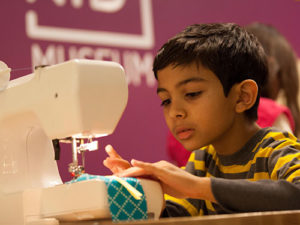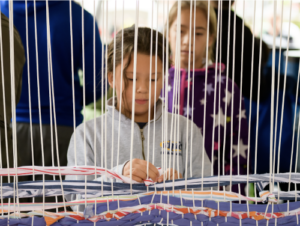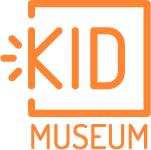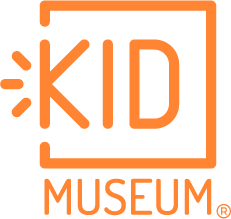 In our new Inside the Maker Studio blog series, we’re diving into the Textiles, Electronics, Fab Lab, and Woodshop Maker Studios with our Studio managers and lead educators. This week, we explore the Textiles Studio with Amrit…
In our new Inside the Maker Studio blog series, we’re diving into the Textiles, Electronics, Fab Lab, and Woodshop Maker Studios with our Studio managers and lead educators. This week, we explore the Textiles Studio with Amrit…
What can KIDs do in the Textiles Maker Studio?
Our textiles programming lets kids explore the world of fabric–both making it and making with it–from weaving their own fabric to following patterns using a sewing machine. Every month, kids can develop skills in our Textiles Studio and become certified Tinkerers, Explorers, and Makers–which unlocks access to Open Build time. We also offer unique workshops like needle felting and making Harry Potter ties, in addition to after-school programs and camps that integrate textiles like Wearable Gadgets.
Tell us about your background and expertise with textiles.
My background in textiles comes from a lifetime of curiosity. Surrounded by sewing experts, I started hand sewing around age 5, creating outfits and furniture for my toys. I was also fortunate that my middle school had a required sewing class, where I made the typical pajama pants, but also followed paper mazes to learn how to navigate the sewing machine. It helped me learn how to troubleshoot my mom’s 1970’s Singer and to read patterns.
Growing up in a small town with the nearest mall over an hour away, much of my shopping in high school was going to local thrift stores and finding clothes to alter. I even designed my own ballet costumes and prom dress. In college, as a manager of dance programs, my experience was put to the test as I designed and created outfits for up to 30 dancers. During this time I took a few costume design courses where I tackled every seamstress’s nightmare: making a corset!
Since college I’ve used my skills to create museum exhibits, storefront window displays, home decor, and performance costumes. More recently, I’ve fallen head over heels with embroidery and cross stitch–it’s like painting with thread. I’ve been on an exploration for a while to embroider non-fabric items like cardboard, shrinky-dink, and porcelain.

Textiles Maker Studio
How does textiles fit into the maker movement, and more specifically, KID Museum’s Mind of a Maker learning philosophy?
Textiles are all around us, and are an essential tool in innovation. From antibacterial workout apparel, to that new pair of sneakers we’re coveting, to space suits–textiles technology is constantly evolving and woven into a variety of industries. Kids can be a part of inventing the future of textiles and its applications.
Plus, with the maker movement, there’s been an incredible resurgence in making textiles by hand. Knitting, embroidery, and tatting have come back full force, and makers are pushing the boundaries of these unique arts. In a day and age of H&M, Forever 21, and other chain stores offering disposable, “fast fashion,” there’s a counter movement to make, upcycle, and personalize your own clothes.
As my textiles after-school group will tell you, making with textiles takes grit. Projects can take a long time, requiring a lot of patience. I’ve also watched kids develop the confidence to create new textiles projects on their own. One of our regular weekend visitors, who has earned all of her textiles certifications, used her skills to weave a piece of fabric and sew it into a pillow for a cardboard treehouse she was building.

Wearable Gadgets Camp
How can textiles skills be used with other maker skills?
Everyone at KID has been receptive to my belief that integrating textiles is essential to a makerspace, all working with me to build textiles into a variety of programming. Our Wearable Gadgets camp is a great example of incorporating textiles skills into more tech-based applications. Kids get to work with sewable circuits using conductive thread to make wearable creations that light up and move. I’m currently exploring the applications of 3D printing onto fabric, and hope to develop a workshop with our Fab Lab manager.
Does the history of computer programming really start with weaving?
Yes, it’s true–weaving inspired coding! In the 1800’s, Charles Babbage was inspired by the Jacquard loom to develop the first “computer” known as the Difference Engine No. 2–an automatic mechanical calculator used to calculate polynomial functions.
The Jacquard loom, built in 1804, simplified the process of creating complex weaving patterns by following a series of punched cards–similar to a computer program. This allowed for incredibly detailed patterns to be made much more quickly.
Babbage corresponded for years with Ada Lovelace, a brilliant 17-year-old mathematician, who observed that the Difference Engine “weaves algebraic patterns just as the Jacquard loom weaves flowers and leaves.” She theorized that eventually these machines could evolve to calculate anything within a fixed set of rules, and she essentially wrote the first computer algorithm, earning her the title of “Mother of Programming.”

Giant Loom at KIDfest
The Difference Engine No. 2 was never built in Babbage’s lifetime, but nearly 150 years later a museum director in London decided to build one and found that it did indeed work!
Who are some innovators in textiles that you go to for inspiration?
Iris van Herpen: With clothing and accessories worn by celebrities like Lady Gaga, van Herpen is pushing the envelope on innovation in clothing design. Her most famous designs include the use of 3D printing, iron filing infused polymers, wire mesh, and laser cut leather.
Julie Taymor: Taymor did the costumes for Lion King on Broadway, combining traditional African textiles with pneumatic devices to make otherwise rigid costumes seem as if they’re moving.
Yinka Shonibare: Shonibare is a Nigerian-British artist who uses traditional African textiles to sew elaborate European style garments, examining cultural identity and colonialism. His work shows the incredible statements we can convey through clothing.
Adam Savage: Yes, that Adam Savage! Since Mythbusters, Savage has spun off onto his own inspiring YouTube channel where he explores makerspaces and creates things himself. One of my favorite videos is Adam Savage’s One Day Builds: Totoro Costume.
Danielle Clough: This artist is an incredible source of inspiration for embroidery. Her stitches ressemble brush strokes, and she pushes the boundaries of what materials can be embroidered. Clough has collaborated with large organizations like Nike, Origins, and Netflix.
Come create and innovate with us in the Textiles Studio! Stay tuned to all of our upcoming textiles programming at our calendar here.

